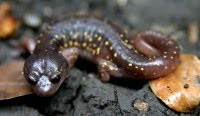
Salamander in all ages been considered a mysterious and mystical animals, as she attributed to the inextricable link with the elements of fire. Ostensibly, this elegant lizard can remain intact in an open fire and even live in it - whether it be a flame or a fire pit of an active volcano.
Meeting the salamander on the slopes of the volcano during the eruption, the medieval alchemists believed that the creation of this is the heart and soul of fire, its personification, and seriously believed that the salamander's body is made up of solidified particles of the ancient flame. It was also thought that the salamander could suddenly appear on the hearth, but she not only burns in the fire, and vice versa - has the power to extinguish the flames, even his unusually cold body and the strange mystical dance.
Fire Salamander

Pliny in his book "Natural History" says it this way: "Salamander is so cold that, if even touches the flame, it immediately turns off, as if it put a piece of ice.
Residents of those areas where forests are inhabited by salamanders, amphibians associated with the many wonderful lore and legends, often bleak. For many people this animal was personified by an otherworldly force. He was perceived as a strange monster, a messenger of hell. It also was one of the symbols of witchcraft and alchemy. Thus, to enhance the action of poisons to the desired substance added to the dried and finely comminuted salamanders.
Image salamanders in medieval manuscripts

Salamandra, depicted in the Middle Ages in the form of a small lizard or Wingless dragon, dancing among the flames, was also a symbol of the alchemical process of burning. Sometimes it portrayed as a human or dog figurines, supposedly living in the fire. Medieval theologians have argued that the salamanders can live in the flames and feed the fire.
In British heraldry salamander was given an honorary role: it meant bravery and courage. In Germany salamander somehow symbolizes beer feast.
But the relationship of this legendary animal with the fire still undeniable, and the first insurance company have salamander its symbol because it represented a safety from fire.
Transcarpathian salamander

Habitats salamanders - Eurasia, North Africa and North America, where there are several subspecies, differing in length and color. In our latitudes, habitat of this amphibian - Transcarpathia.
Fire (or spotted) salamander - a beautiful and quite large (up to 25 cm long) lizard. This is the most familiar to us, except for newts, Caudata. For the most part this land animals, their fingers are deprived of swimming membranes, and therefore in a deep lake, with no possibility of escape, the salamander may drown.
On land, she feels confident enough. Massive, wide body, short but strong legs and powerful jaws make it a strong and swift hunter. Hunt salamanders, throwing, like frogs, language. But, unlike frogs and toads, they lack not only moving, but stationary feed, which are using the olfactory system.
Allegory of salamanders in the form of a woman

Favorite places of these amphibians are mountainous and foothill forests, where they give special preference for beech, but not neglected, and mixed, and even the coniferous forests. Beech trees are the same, and especially lying on the ground rotting trunks of beech, these lizards are particularly fond of. They were happy to settle within them, where even in drought season is a high moisture content, suitable both for the amphibians, as well as for life and reproduction of "live feed" - many invertebrates.
You can often find salamander in the valleys and slopes of the mountain rivers, overgrown with ferns and studded with stones covered with moss.
In a favorable time of year - summer, autumn and spring - amphibians find themselves refuge everywhere: this is a heap of leaves and fallen branches, and courtines moss, and animal burrows. But winter salamanders crawl into a little deeper - in rodent burrows and other underground cavities, sometimes reaches a depth of 2 meters, where sometimes even accumulate a few hundred individuals.
Peace-loving and harmless in nature, salamanders, however, are well armed. The main weapon of these beautiful, like a painted lizards is their brightest "aggressive" color. Skin color - mostly black coated with a bright yellow or orange spots and stripes - intended to act scares the enemies. In addition, salamanders may, if necessary, to provide paralytic poison - salamandrin - and if anything can be put into operation a weapon capable of hitting any animal to death of small size, even the dog. A lethal dose of poison salamanders Carpathian for dogs is only 0.8 mg per 1 kg of body weight.
- You look at me? Well, I'll look at you! We can even meet!

Poison animal protection, in addition, his bare skin from bacterial and fungal infections. For man is poison salamanders are not dangerous.
Produced salamandrin (sticky secret milk color) so-called parotidami - skin glands, located behind the eyes, and have the kind of large, elongated warts.
Fire salamander - a bright and beautiful animal - thanks to its exotic color can decorate and liven up any terrarium and become a real gem of a home living corner.
About the same content and feeding of amphibians in the home will be discussed in the next article.
Marina Dutta
http://animaldin.blogspot.com/
No comments:
Post a Comment